English homeowners go into political battle over murals
- Published
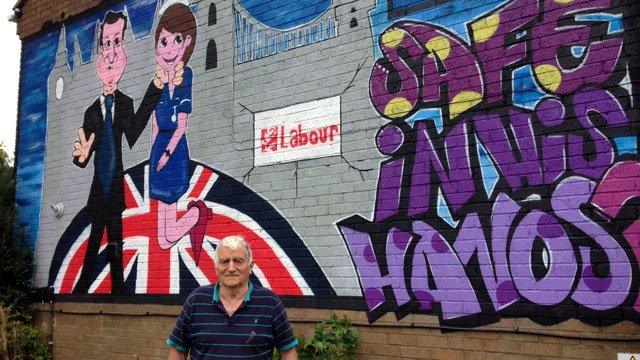
Tony and Veronica Davis's mural has caused a stir in Little Stoke
In parts of England, homeowners have been getting things off their chests and on to the exterior walls of their homes - to the ire of councils and some neighbours. With some digging their heels in, what are the rules surrounding the illustrations?
Pensioners Tony and Veronica Davis are not shy about nailing their colours to the mast, or, more precisely, the wall of their 1960s end-of-terrace in Little Stoke, near Bristol.
Weeks before the general election, the Labour supporters paid an artist to paint a huge mural on the wall, featuring David Cameron with his hands around a nurse's throat.
It attracted media attention, external and a letter from South Gloucestershire Council telling them to remove the "illegal advertisement" by 12 May or potentially face a fine of £2,500.
The Davises are accused of breaking one of the few rules governing what can be painted on your own house - but, more than a month after the deadline, the mural remains.
A planning authority's decisions rest on whether it considers such an illustration to be an advert - if so, permission is required under the Town and Country Planning (Control of Advertisements)(England) Regulations 2007.
Beach hut
The couple have been here before - after attaching another Conservative-bashing message to the wall in the run up to the 2010 general election.
Then though, the message was on wood and mounted on the wall. This time, they think the council is on thin ice and have instructed a solicitor to put it to the test.
They are not the only homeowners digging their heels in over an unusual paint job.
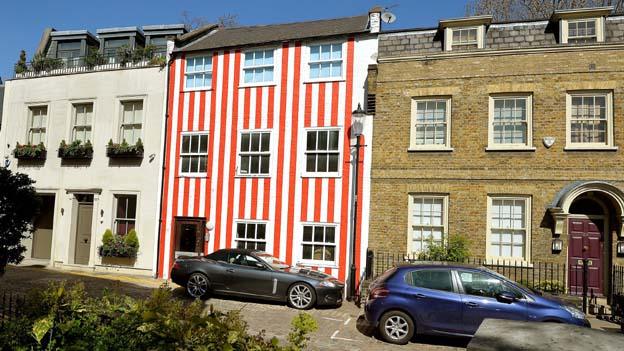
Zipporah Lisle-Mainwaring said she was "entitled to do what I wish" with her own house
In an exclusive cul-de-sac in London's Kensington, a multi-million pound townhouse has been painted in red and white stripes since April.
It caught the eye of planning officers, not to mention the neighbours, who have likened it to a giant beach hut.
Owner Zipporah Lisle-Mainwaring has denied it was done to spite her neighbours following a planning row and told the Evening Standard, external: "It is my house, I am entitled to do what I wish with it, and there are a lot of people who agree with me."
Kensington and Chelsea Council though was not among them. It has told her to get rid of the stripes and fix the property's windows, which the council says are in poor repair, by 3 July - citing "numerous complaints" and the fact it is in a conservation area.
It is using powers under the Town and Country Planning Act 1990 to issue a section 215 notice, which requires land to be "cleaned up when its condition adversely affects the amenity of the area" - something Ms Lisle-Mainwaring has indicated she plans to fight.
It seems though, others can dramatically transform their houses, without provoking an outcry.

Bristol artist Alex Lucas has been trying to persuade others to bring interior design outside
It is an idea artist Alex Lucas was trying to promote at last month's Grand Designs exhibition in London. Her red Victorian terrace, bedecked with hand-painted birds and flowers, has become a bit of a landmark in Bristol's bohemian Montpelier area.
When she planned to create something "for everyone to enjoy" five years ago, the city council was wary but has since been more enthusiastic. Ms Lucas says her Picton Street neighbours are supportive.
"Crossed fingers, I haven't had a negative reaction," she said.
But, when she tried to promote the idea in London, at a time when the "stripy house" was in the headlines - she admits people "got worried".
"They were like: 'What do your neighbours think?'," she says.
"The main thing was 'Were you allowed to?'"
'Wiggle room'
In Bristol, the council says murals are generally allowed, as long as they do not stray into advertising, but each case is assessed individually. The city's links to Banksy, for example, are well documented and in Stokes Croft, home to his "Mild, Mild West" mural, large scale paintings are commonplace.
Brighton and Hove City Council says it is "considering its approach" after murals appeared on Viaduct Road in March when the authority had requested residents to clean up the street.
The council has commissioned street art in the past but it says it is "considering the powers available to us" when it comes to murals on private property, seeking an agreement "for the benefit of everyone".
The government says it is something for councils to decide, "on a case-by-case basis". Conservation areas and listed buildings may be subject to "general permitted development orders" or the Planning Act 1990.
Jonathan Smithers, vice president of the Law Society of England and Wales, says much depends on how courts interpret the law.
In conservation areas, there is an obligation on the planning authority to "preserve the character and nature of the area" - which might make Ms Lisle-Mainwaring's task more difficult.

Graffiti artist Aroe MSK was commissioned by a landlord to paint this mural in Viaduct Road, Brighton.
But he said there was often "some wiggle room... depending on the circumstances".
"Supposing you painted your house the colour of that purple that Cadbury uses, so it looked like a chocolate bar. Would that be an advert or are you just choosing the colour purple? There's a subtlety in that," he said.
'Personality and style'

Bristol artist Cheba gave this backpacker hostel a facelift in December
Sophie Vening, editor of Grand Designs Magazine, said those planning a property facelift should consider the neighbourhood when adding "personality and individual style to your home".
"Candy-coloured exterior walls blend in perfectly on Brighton's seafront and Banksy artwork looks great in inner cities, for example - be aware that it may not suit everyone's tastes," she said.
Back in Little Stoke, it is two months since the Davises had their wall painted. The Conservatives have returned to power - but the mural remains, to a mixed reaction locally.
"Eyesore" was among comments on a local Facebook page - "Not sure about the nurse throttling", was another. Others were more supportive: "Brings some character to the area, I like it".
The couple plan to challenge the argument it is an advert. Their offer to remove the word "Labour" has not been accepted. The council has also suggested the "offensive" image may come under anti-social behaviour laws.
Enforcement officers have been sent out to look at it again and the council says prosecution proceedings have begun.
But, Mr Davis maintains they are "scraping the bottom of the barrel" looking for reasons to have it removed.
"We made a point this time of not putting up a hoarding - it's a mural... some people just don't like street art," he added.
- Published28 April 2015
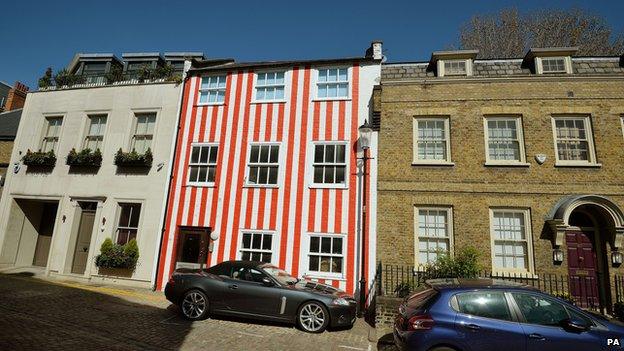
- Published4 March 2013
- Published28 February 2015
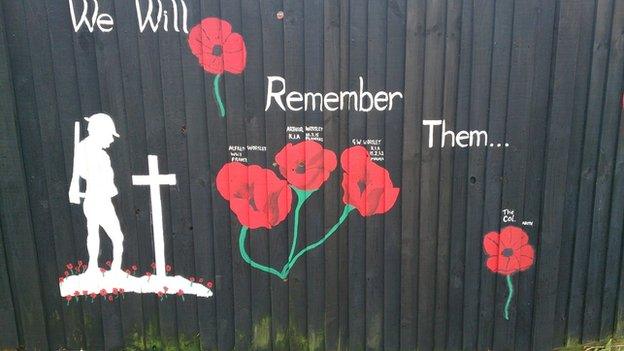
- Published19 February 2015
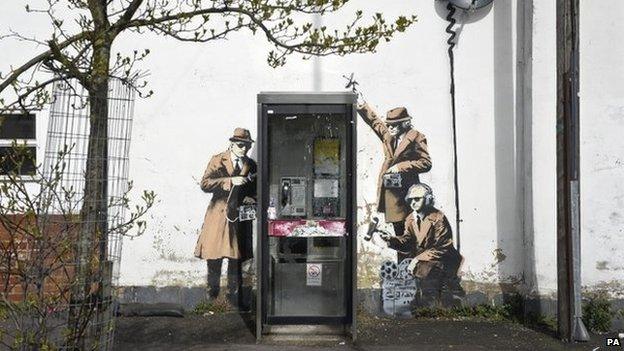
- Published21 July 2012
